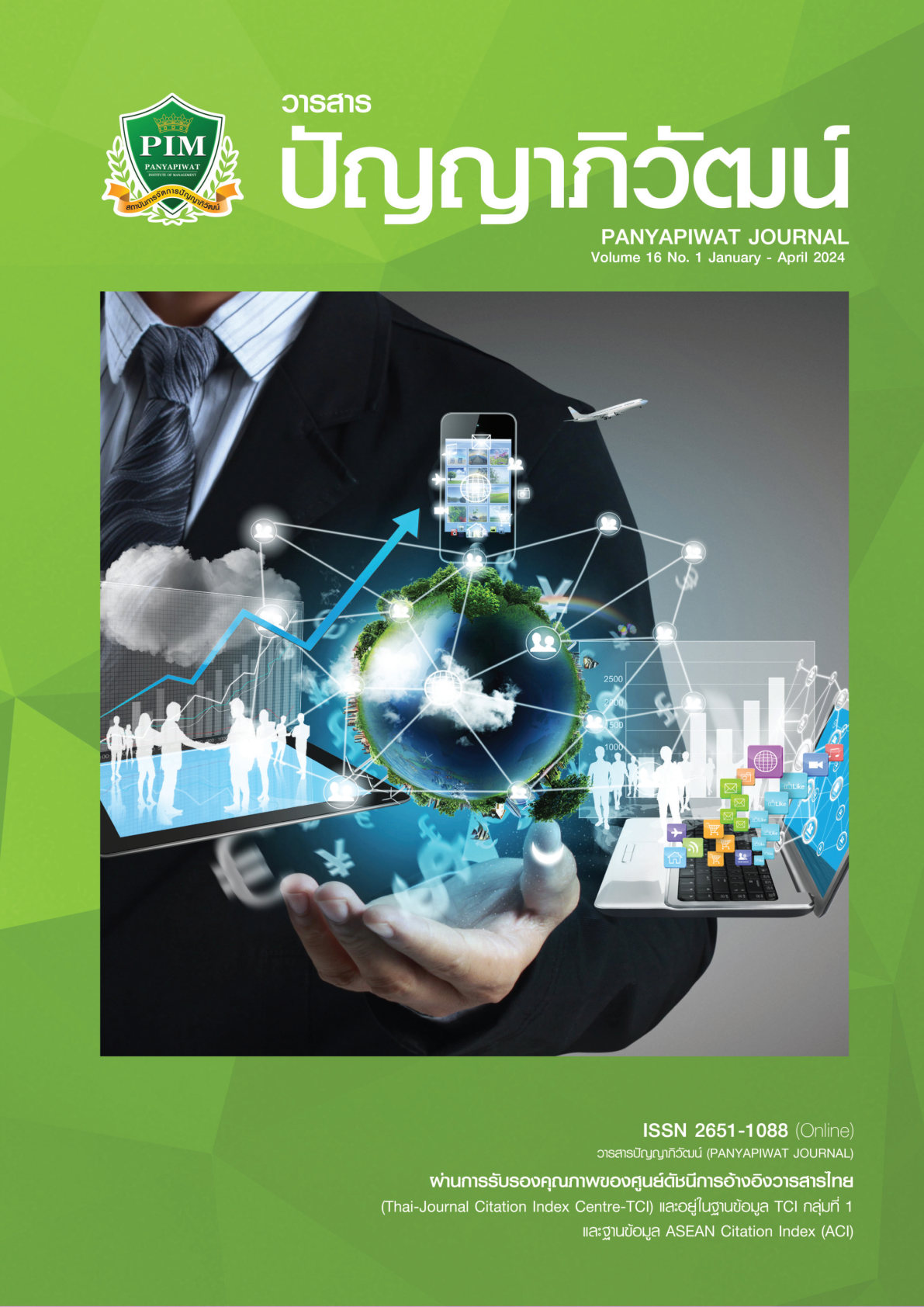การพัฒนารูปแบบวิทยาการจัดการเรียนรู้แบบผสมผสานตามทฤษฎีความรู้ในเนื้อหา ผนวกวิธีสอนและเทคโนโลยีเพื่อพัฒนาความสามารถทางการสื่อสารภาษาอังกฤษ ของนักศึกษาระดับปริญญาตรี ในสถาบันการศึกษาเอกชน
Main Article Content
บทคัดย่อ
การวิจัยครั้งนี้มีวัตถุประสงค์เพื่อพัฒนาและศึกษาผลการใช้รูปแบบวิทยาการจัดการเรียนรู้แบบผสมผสานตามทฤษฎีความรู ้ในเนื้อหาผนวกวิธีสอนและเทคโนโลยีเพื่อพัฒนาความสามารถทางการสื่อสารภาษาอังกฤษของนักศึกษาระดับปริญญาตรี ในสถาบันการศึกษาเอกชน วิธีการวิจัยเป็นการวิจัยและพัฒนา (Research and Development) โดยใช้ระเบียบวิจัยแบบผสมผสาน ด้วยการศึกษาเชิงปริมาณ (Quantitative Method) และวิธีการเชิงคุณภาพ (Qualitative Methods) และใช้แบบแผนการทดลองแบบทดสอบกลุ่มเดียวสอบก่อน-หลัง (One Group Pretest- Posttest Design) กลุ่มตัวอย่างคือ นักศึกษาระดับปริญญาตรี สถาบันการจัดการปัญญาภิวัฒน์ ได้มาโดยวิธีการสุ่มแบบหลายขั้นตอน (Multi-Stage Sampling) จำนวน 80 คน เครื่องมือที่ใช้ในการวิจัย ประกอบด้วย แบบสัมภาษณ์ผู ้เกี่ยวข้อง แผนการจัดการเรียนรู้เพื่อพัฒนาความสามารถทางภาษาอังกฤษเพื่อการสื่อสาร แบบทดสอบวัดความสามารถทางภาษาอังกฤษเพื่อการสื่อสาร แบบสอบถามความพึงพอใจของผู้เรียนที่มีต่อรูปแบบวิทยาการจัดการเรียนรู้ ดำเนินการวิเคราะห์ข้อมูลเชิงคุณภาพโดยการวิเคราะห์เนื้อหา (Content Analysis) และใช้สถิติเชิงพรรณาโดยการหาสถิติ ค่าเฉลี่ย ค่าส่วนเบี่ยงเบนมาตรฐาน และสถิติทดสอบแบบไม่อิสระ (T-Test Dependent)
ผลการวิจัยพบว่า สภาพการจัดการเรียนรู้แบบผสมผสานฯ ในสถาบันการศึกษาเอกชน แบ่งออกเป็น 5 ประเด็น ดังต่อไปนี้ 1) ด้านการปรับตัวในการเรียนรู้ของผู้เรียน 2) ด้านการประยุกต์ใช้เทคโนโลยีในการจัดการเรียนการสอน 3) ด้านการวัดและประเมินผลการเรียนรู้ 4) ด้านการออกแบบการจัดการเรียนรู้ในรูปแบบผสมผสาน (Blended Learning) และ 5) ด้านแนวทางในการออกแบบการสอนโดยการประยุกต์ใช้เทคโนโลยี รูปแบบวิทยาการจัดการเรียนรู้แบบผสมผสานตามทฤษฎีความรู้ในเนื้อหาผนวกวิธีสอน และเทคโนโลยี เพื่อพัฒนาความสามารถทางการสื่อสารภาษาอังกฤษในสถาบันการศึกษาเอกชน ประกอบด้วยองค์ประกอบที่สำคัญ 6 ประการคือ 1) หลักการ 2) วัตถุประสงค์ 3) สมรรถนะทางการเรียนรู้ 4) สิ่งสนับสนุนทางการเรียนรู้ 5) กระบวนการ การจัดการเรียนรู้ ซึ่งประกอบไปด้วย การเรียนรู้ภายในห้องเรียน การเรียนรู้ภายนอกห้องเรียน และ 6) การวัดและประเมินผล และรูปแบบมีประสิทธิภาพเท่ากับ 72.62/79.01
ผลการศึกษาผลการใช้รูปแบบวิทยาการจัดการเรียนรู้แบบผสมผสาน พบว่า 1) ผลการเปรียบเทียบความสามารถทางการสื่อสารของกลุ่มตัวอย่างที่เรียนด้วยรูปแบบวิทยาการจัดการเรียนรู้ฯ สูงกว่าก่อนเรียนอย่างมีนัยสำคัญทางสถิติที่ระดับ .05 โดยมีค่าเฉลี่ยและค่าส่วนเบี่ยงเบนมาตรฐานอยู่ที่ x̄ = 55.31, S.D. = 8.91 และ 2) ความพึงพอใจต่อการเรียนด้วยรูปแบบการจัดการเรียนรู้แบบผสมผสานตามทฤษฎีการผสมผสานความรู้และเทคโนโลยี โดยรวมอยู่ในระดับมาก (x̄ = 4.10, S.D. = 0.81)
Article Details

อนุญาตภายใต้เงื่อนไข Creative Commons Attribution-NonCommercial-NoDerivatives 4.0 International License.
“ข้าพเจ้าและผู้เขียนร่วม (ถ้ามี) ขอรับรองว่า บทความที่เสนอมานี้ยังไม่เคยได้รับการตีพิมพ์และไม่ได้อยู่ระหว่างกระบวนการพิจารณาลงตีพิมพ์ในวารสารหรือแหล่งเผยแพร่อื่นใด ข้าพเจ้าและผู้เขียนร่วมยอมรับหลักเกณฑ์การพิจารณาต้นฉบับ ทั้งยินยอมให้กองบรรณาธิการมีสิทธิ์พิจารณาและตรวจแก้ต้นฉบับได้ตามที่เห็นสมควร พร้อมนี้ขอมอบลิขสิทธิ์บทความที่ได้รับการตีพิมพ์ให้แก่สถาบันการจัดการปัญญาภิวัฒน์หากมีการฟ้องร้องเรื่องการละเมิดลิขสิทธิ์เกี่ยวกับภาพ กราฟ ข้อความส่วนใดส่วนหนึ่งและ/หรือข้อคิดเห็นที่ปรากฏในบทความข้าพเจ้าและผู้เขียนร่วมยินยอมรับผิดชอบแต่เพียงฝ่ายเดียว”
เอกสารอ้างอิง
Allen, I. E., & Seaman, J. (2005). Growing by degrees: Online education in the United States, 2005. Sloan Consortium.
Angwatanakul, S. (1997). English teaching methodology (4th ed.). Faculty of Education, Chulalongkorn University. [in Thai]
Bailey, K. M. (2005). Practical English language teaching: Speaking. McGraw-Hill
Berman, M. (2003). Advanced listening. Dynamic Education International Inc.
Bloom, B. S. (1956). Taxonomy of educational objectives, handbook: The cognitive domain. David McKay.
Boud, D., & Griffin, V. (1987). Appreciating adults learning: From the learner’s perspective. Kogan Page.
Brahmawong, C. (2013). Developmental testing of media and instructional package. Silpakorn Educational Research Journal, 5(1), 7-20. https://old.educ.su.ac.th/2013/images/stories/081957-02.pdf [in Thai]
Candy, P. C. (1991). Self-direction for lifelong learning. Jossey-Bass.
Carman, J. M. (2005). Blended learning design: Five key ingredients. http://www.agilantlearning.com/pdf/Blended%20Learning%20Design.pdf
Department of Academic Affairs. (2008). Strands and content standards foreign languages department. Basic education curriculum 2008. Wattana Phanit Publishing House, Chulalongkorn University. [in Thai]
Graham, C. R. (2013). Emerging practice and research in blended learning. In M. G. Moore (Ed.), Handbook of distance education (pp. 333-350). Routledge
Holec, H. (1981). Autonomy and foreign language learning. Pergamon Press. http://www.p21.org/storage/documents/21st_century_skills_education_and_competitiveness_guide.pdf
Isaacs, T., Zara, C., Herbert, G., Coomes, S. J., & Smith, C. (2013). Key concepts in educational assessment. Sage.
Jamjareon, S. (2017). English listening and speaking skill development by English language activities. Academic Journal Phranakhon Rajabhat University, (71), 85-91. https://so01.tci-thaijo.org/index.php/AJPU/article/view/65514 [in Thai]
Kaewpanngam, C. (2018). Approaches in integrating digital technologies in language teaching. Pasaa Paritat Journal, Language Center, Chulalongkorn University, 33, 241-266. https://www.culi.chula.ac.th/Images/asset/pasaa_paritat_journal/file-7-69-e8xfz2712886.pdf [in Thai]
Koehler, M. J. (2016). Technological Pedagogical Content Knowledge (TPACK) (2nd ed.). Routledge.
Kruse, K. (2010). Introduction to instructional design and the ADDIE model. http://www.transformativedesigns.com/id_systems.html
Larsen-Freeman, D. (2000). Techniques and principles in language teaching (2nd ed.). Oxford University Press.
Oliver, M., & Trigwell, K. (2005). Can ‘blended learning’ be redeemed? e-learning. Sage journal, 2(1), 17-25. https://journals.sagepub.com/toc/ldma/2/1
Panich, V. (2012). How to create learning for students in 21st century. Tathata Publication Company Limited.
Partnership for 21st Century Skills. (2007). Beyond the three Rs: Voter attitudes toward 21st century skills. https://repositorio.ul.pt/bitstream/10451/847/4/20103_ulsd_dep.17852_tm_anexo1c.pdf.pdf
Raimes, A. (1987). Techniques in teaching writing. Oxford University Press.
Ritcharoon, P. (2016). Principles of measurement and evaluation. House of Kermyst. [in Thai]
Sangboonraung, W (2019). Development of active learning model through virtual technology to promote analytical thinking for higher education students. Journal of Humanities and Social Science Udon Thani Rajabhat University, 8(2), 211-230. https://so06.tci-thaijo.org/index.php/hsudru/article/view/211782/161433 [in Thai]
Sanjaiprom, S (2011). The development of educational evaluation system for student’s achievement. Chiang Mai Rajabhat University. http://www.cmruir.cmru.ac.th/handle/123456789/582?locale=th
Shulman, L. (1986). Paradigms and research programs in the study of teaching: A contemporary perspective (3rd ed.). Macmillan.
Thompson, A., & Mishra, P. (2008). Breaking news: TPACK becomes TPACK! Journal of Computing in Teacher Education, 24(2), 38-64.
Wankong, U. (2016). English teaching in the 21st century. Journal of Yanasangvorn Research Institute Mahamakut Buddhist University, 7(2), 303-314. https://so04.tci-thaijo.org/index.php/yri/article/view/184935 [in Thai]


